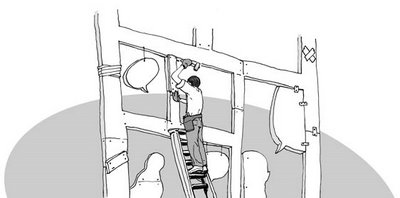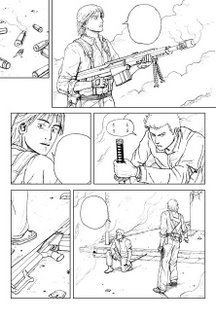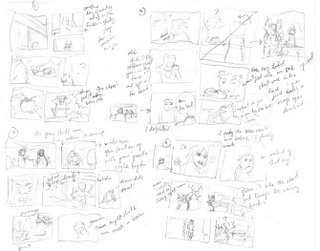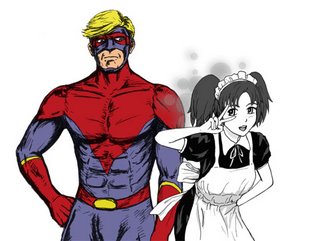

You can read the completed Page 1 as a teaser right here and I'll be adding another four pages (including the finished two from above) real soon. Stay tuned!
Scrap blog of discarded ideas: drawings, comics, manga, sketches and thoughts.


You can read the completed Page 1 as a teaser right here and I'll be adding another four pages (including the finished two from above) real soon. Stay tuned!







 [click the picture to view a larger version]
[click the picture to view a larger version] [click the pictures to view a larger version]
[click the pictures to view a larger version] Using Channels, I select every color channel and load them as a selection so that all the white spaces (background) between the line art are selected. I then delete the white background thus leaving the line art on its own layer. By doing this I can add tones on layers beneath that of the line art. Doing so will allow for easier adjustments to the tones and also for colors to be added later all without effecting the line art.
Using Channels, I select every color channel and load them as a selection so that all the white spaces (background) between the line art are selected. I then delete the white background thus leaving the line art on its own layer. By doing this I can add tones on layers beneath that of the line art. Doing so will allow for easier adjustments to the tones and also for colors to be added later all without effecting the line art. Now comes the bulk of the editing job, zooming right into the pixels to clean the artwork from inking mistakes or dust from scanning. Cleaning takes up a lot of my time no thanks to my messy inking. Photoshop’s Polygonal Lasso tool is my (second) best friend because it makes it so much easier to edit the line art compared to the Eraser tool.
Now comes the bulk of the editing job, zooming right into the pixels to clean the artwork from inking mistakes or dust from scanning. Cleaning takes up a lot of my time no thanks to my messy inking. Photoshop’s Polygonal Lasso tool is my (second) best friend because it makes it so much easier to edit the line art compared to the Eraser tool.
 After clean up I insert the dialogue using fonts made for comics. Not much work involved here since all I have to do is type in the text based on the dialogue I wrote from earlier. Finally tones are applied to add body to the line art. The tones I use are basically just various levels of gray by using the Grayscale slider which are then painted on with the Brush tool. For some of the tones I erase the edges to give it an etched effect like with real tones you’ll see in real manga. With toning done I now have a sparkly new comic to show the world.
After clean up I insert the dialogue using fonts made for comics. Not much work involved here since all I have to do is type in the text based on the dialogue I wrote from earlier. Finally tones are applied to add body to the line art. The tones I use are basically just various levels of gray by using the Grayscale slider which are then painted on with the Brush tool. For some of the tones I erase the edges to give it an etched effect like with real tones you’ll see in real manga. With toning done I now have a sparkly new comic to show the world.
 [click the picture to view a larger version]
[click the picture to view a larger version] [click the pictures to view a larger version]
[click the pictures to view a larger version] I use standard A4 paper (a format that’s only a little longer than Letter in the U.S.A) for my comics. The only thing that I am particular about is the whiteness of the paper; the whiter it is the better it’ll be for scanning the artwork on it which I will touch on later.
I use standard A4 paper (a format that’s only a little longer than Letter in the U.S.A) for my comics. The only thing that I am particular about is the whiteness of the paper; the whiter it is the better it’ll be for scanning the artwork on it which I will touch on later. I pencil exactly like I sketch, all hairy and messy, so it’s no surprise that the eraser is my best friend. The pencil types I use are 2H wooden pencils since they are light enough to not leave too much lead traces after erasing. I don’t like using mechanical ones for no apparent reason. As for erasers I prefer the soft rectangular kind and any make will do.
I pencil exactly like I sketch, all hairy and messy, so it’s no surprise that the eraser is my best friend. The pencil types I use are 2H wooden pencils since they are light enough to not leave too much lead traces after erasing. I don’t like using mechanical ones for no apparent reason. As for erasers I prefer the soft rectangular kind and any make will do. Having completed the penciling of every page of the comic, it’s time to ink them. Even though inking is a fairly easy process of tracing over the pencil lines I still make mistakes like drawing the lines too thick or smudging the ink due to my being left-handed. I don’t use whiteout or white paint to correct those mistakes, I’ll leave them as they are and fix them later on the computer.
Having completed the penciling of every page of the comic, it’s time to ink them. Even though inking is a fairly easy process of tracing over the pencil lines I still make mistakes like drawing the lines too thick or smudging the ink due to my being left-handed. I don’t use whiteout or white paint to correct those mistakes, I’ll leave them as they are and fix them later on the computer. [click the pictures to view a larger version]
[click the pictures to view a larger version] Should I draw the character from the side or from behind? Is it better to draw a close-up of the characters or a panoramic view of the surroundings? With so many possibilities to illustrate a scene in a panel, and having to keep in mind to maintain the continuance of the scene from the last panel, it’s almost a constant battle to arrive at a decision. When I’m finally done I’ll have to repeat the whole decision process again for the following panel. So it’s no surprise that I find storyboarding a time consuming struggle, but it’s unavoidable since it’s such a crucial step to creating comics.
Should I draw the character from the side or from behind? Is it better to draw a close-up of the characters or a panoramic view of the surroundings? With so many possibilities to illustrate a scene in a panel, and having to keep in mind to maintain the continuance of the scene from the last panel, it’s almost a constant battle to arrive at a decision. When I’m finally done I’ll have to repeat the whole decision process again for the following panel. So it’s no surprise that I find storyboarding a time consuming struggle, but it’s unavoidable since it’s such a crucial step to creating comics. Based on the storyboard I write the comic’s dialogue in the form of a script for each character in each panel as needed. Good dialogue is crucial to giving life to the comic’s characters by making them believable so that the reader is able to relate to them. I use pointers, such as the character’s personality, relationship with other characters, emotional states and reaction to events, to help me think of what they say and how they say it.
Based on the storyboard I write the comic’s dialogue in the form of a script for each character in each panel as needed. Good dialogue is crucial to giving life to the comic’s characters by making them believable so that the reader is able to relate to them. I use pointers, such as the character’s personality, relationship with other characters, emotional states and reaction to events, to help me think of what they say and how they say it. I think most comic creators design their comic’s characters at an earlier phase and in more detail than I do. Somehow I prefer to leave character design until the last part of the planning process. I don’t do detailed visual profiles like full body front views, side views and such. I usually only do headshot sketches of a character to work out his or her unique features to portray their personality. I would also create a personal back story of the character to help me envision their typical postures and how they would visually react to situations.
I think most comic creators design their comic’s characters at an earlier phase and in more detail than I do. Somehow I prefer to leave character design until the last part of the planning process. I don’t do detailed visual profiles like full body front views, side views and such. I usually only do headshot sketches of a character to work out his or her unique features to portray their personality. I would also create a personal back story of the character to help me envision their typical postures and how they would visually react to situations. I first started my foray into comics with the likes of Marvel and DC superhero comic books. When American comic publishes started bringing in translated manga such as Akira and Appleseed I found myself gravitating towards these comics from the Far-East and neglected to collect my monthly issues of The Uncanny X-men.
I first started my foray into comics with the likes of Marvel and DC superhero comic books. When American comic publishes started bringing in translated manga such as Akira and Appleseed I found myself gravitating towards these comics from the Far-East and neglected to collect my monthly issues of The Uncanny X-men. How I'm learning to make comics: part 1
How I'm learning to make comics: part 1